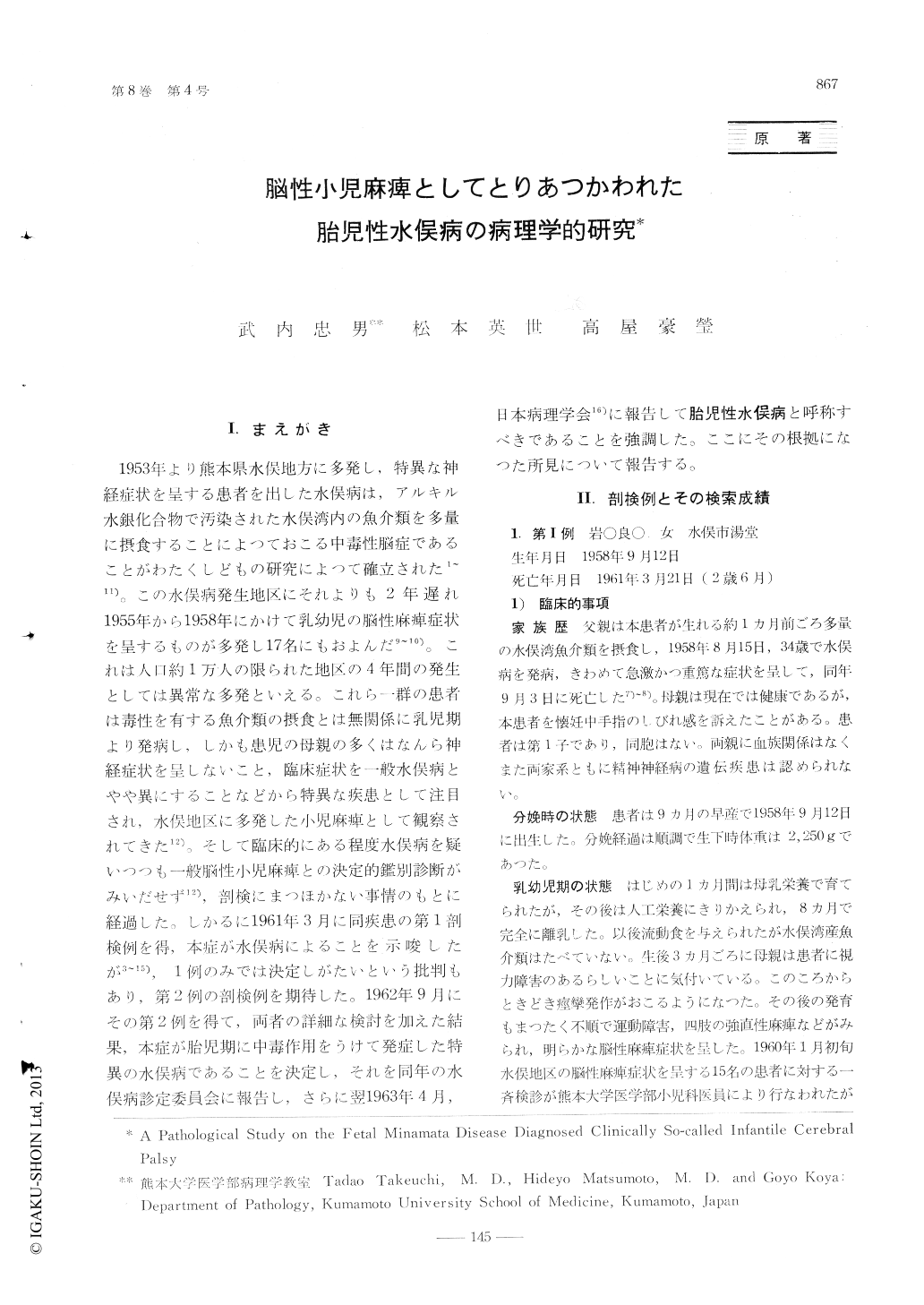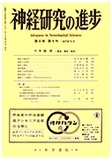Japanese
English
- 有料閲覧
- Abstract 文献概要
- 1ページ目 Look Inside
I.まえがき
1953年より熊本県水俣地方に多発し,特異な神経症状を呈する患者を出した水俣病は,アルキル水銀化合物で汚染された水俣湾内の魚介類を多量に摂食することによつておこる中毒性脳症であることがわたくしどもの研究によつて確立された1〜11)。この水俣病発生地区にそれよりも2年遅れ1955年から1958年にかけて乳幼児の脳性麻痺症状を呈するものが多発し17名にもおよんだ9〜10)。これは人口約1万人の限られた地区の4年間の発生としては異常な多発といえる。これら一群の患者は毒性を有する魚介類の摂食とは無関係に乳児期より発病し、しかも患児の母親の多くはなんら神経症状を呈しないこと,臨床症状を一般水俣病とやや異にすることなどから特異な疾患として注目され、水俣地区に多発した小児麻痺として観察されてきた12)。そして臨床的にある程度水俣病を疑いつつも一般脳性小児麻痺との決定的鑑別診断がみいだせず12),剖検にまつほかない事情のもとに経過した。
From 17 patients of so-called infantile cerebralpalsy diagnosed clinically in Minamata area of Ku-mamoto prefecture, two autopsy cases were patho-logically investigated and it was determined fromthe following results that this disease is a Mina-mata disease (methylmercury compound poisoning)of infants caused by the poisoning in the fetalperiod.
A. The results obtained as the base of diagnosisof Minamata disease.
1) The similar patients of Minamata diseasewere observed in the same family in the fetalperiod of these two autopsy cases; a female infantaged 2.6 years whose father fell ill in her fetalsixth month and a female child aged 6.3 yearswhose brother took the same disease in her fetaleightth month. Disturbance of movements, rigidityof the extremities, paroxysmal convulsion, visualdisturbance, slight deafness, and mental detardationwere clinically observed in both cases.
2) A considerable amounts of mercury were che-mically demonstrated in the hair of both the infantsand their mothers during their lives. The samesmall amounts of mercury as seen in the chroniccases of Minamata disease were demonstrated inthe brain, liver, kidney, and hair of the autopsyeases.
3) Striking features in pathology were neuronaldisturbances showing microencephalia with thelobular atrophy of both cerebral hemispheres con-taining the calcarine and central cortices and alsowith the cerebellar atrophy of granule cell type.
4) In the cerebral cortex various grade of de-crease and loss of neurons accompanied with slightglia proliferation were noted in total layers of cyto-architecture, particulary in the deeper sulci of bothhemispheres.
5) In the cerebellum the granule cells predom-inantly decreased and disappeared, particularly inthe central area of both hemispheres and verrnis.Purkinje cells were disintegrated more slightly.
B. The results considered to be the fetal pathoge-nesis.
1) The patients had the same episodes of theMinamata disease in their fetal period.
2) There were disturbances of development andgrowth in the brain, particularly delay of thegrowth of neurons and hypoplasia of cytoarchitec-tures. The striking features were the rest of matrixcells at the ventricular walls, remaining nervecells in medulla, hypoplasia and malformation ofnerve cells and hypoplasia of corpus callosum inboth cases, and columnar grouping of nerve cellsand malformation of cytoarchitecture in cerebellarlayers of central region in hemispheres respectivelyin each ease.
3) Abnormal nystagmus and anomaly of teetharrangement were noted, while there was no mal-formation on the body.
4) It was considered from disturbances of neu-ronal growth and lack of the body malformationthat a toxic agent might disturbe the nerve cellsdifferentiated relatively well in the intermediateand late period of a total fetal life.
5) There was a possibility of placental poisoningin Minamata disease from a experimental factobtained in our laboratory that alkylmercurycompound administrated orally to the mother catduring pregnancy may cause microencephalia con-taining the loss of nerve cells in cerebral corticesand the disappearance of granule cells in cerebellumin the child eat.
This investigation was supported by a Research.Grant (EF 278-2) from the United State PublicHealth Service.

Copyright © 1964, Igaku-Shoin Ltd. All rights reserved.


